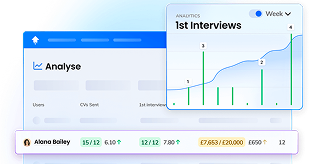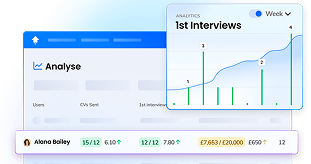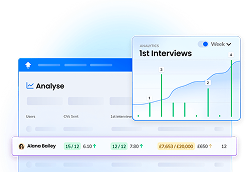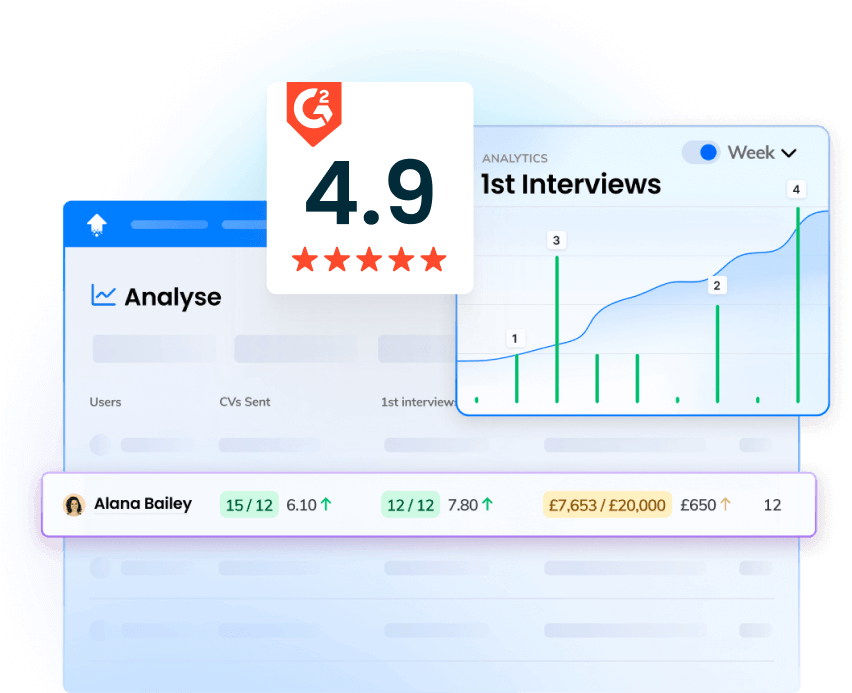Time to Fill and Time to Hire are two key recruitment metrics often mixed up.
Admittedly, there is some overlap between the two metrics — they reveal crucial insights into the effectiveness and efficiency of your recruitment agency's processes.
However, Time to Fill and Time to Hire focus on different windows of time within the recruitment process — meaning their outcomes are always different.
This means you gain different — but equally important — insights from tracking and analysing each metric.
It's vital that recruitment leaders understand both Time to Hire and Time to Fill to interpret and analyse their data accurately.
What is Time to Fill?
Time to Fill tells you how many days, on average, it takes to fill a job opening, revealing the efficiency of the entire hiring process.
It tracks the duration from when the job arises to when the role is filled.
If your Time to Fill is incredibly long, compared to previous months or quarters — or industry benchmarks — this alerts you to potential issues within your processes.
You can then drill down into the data to isolate the issue or issues in question and work to rectify them.
This is a massive win for any recruitment agency.
A low Time to Fill means enhanced client satisfaction and increased efficiency, ultimately boosting revenue.
If you're not tracking your Time to Fill, you're likely missing out on crucial insights that could significantly boost your agency's bottom line.
How to Calculate Time to Fill
To calculate Time to Fill you must first define your start and end points — which vary from agency to agency.
So, it's up to you to define these parameters for your agency.
You may consider the start of your Time to Fill window the point at which the job requisition is approved, the day the job is added to your agency, or the date the job posting is first advertised.
Time to Fill metrics usually end when the candidate signs their contract, but some agencies may use the candidate's start date as the cut-off point.
It makes sense for most agencies to track the parts of the process they control.
For example, if you set your start date when the vacancy was internally green-lit within your client's business, you may be accounting for days or weeks when your agency was unaware the role existed.
Similarly, using the candidate's start date as a cut-off point accounts for internal processes and timelines within the client company, so it could be more helpful for most recruitment agencies.
But whatever your parameters, you must keep them consistent for accurate insights into the efficiency of your agency's processes.
Once you've decided on your start and end points, calculating Time to Fill is pretty straightforward.
Simply add the days between your start and end point to reveal your Time to Fill for a specific role.
How to Calculate Average Time to Fill
To find out your agency's average Time to Fill, add up all the days it took to fill every role within a given time period.
Now divide this figure by the number of jobs filled.
Here's an example.
Suppose you want to calculate your average Time to Fill for the past month.
In the past month, you have filled five different roles.
Role 1 took ten days to fill, role 2 took 20 days to fill, role 3 took 15 days to fill, role 4 took 30 days to fill, and role 5 took 45 days to fill.
First, add up all these days like so: 10+20+15+30+45 = 120 total days to fill.
Now, divide this figure by the number of jobs filled: 120/5 = 24.
There you have it — your average Time to Fill for the past month was 24 days.
Some agencies fill roles with high turnover that are always open. It's important to leave these out of your Time to Fill calculation, as it will inflate the figure and give you an accurate picture of the efficiency of your processes.
What's a Good Benchmark for Time to Fill?
The average Time to Fill is 42 days, according to research from The Society of Human Resource Management (SHRM).
However, this figure can vary wildly by industry or sector — or even geographic location.
Furthermore, the average Time to Fill can vary from year to year, depending on the market's state and the broader economic climate.
For example, according to Gartner surveys, Time to Fill a role increased by 18 per cent from 2020 to 2021 — which translates to two extra weeks to fill a role.
This is why it's essential to do your own research when benchmarking.
During your benchmarking exercise, take into account:
- Overall average Time to Fill
- Average Time to Fill within your industry or sector
- Your competitors' Average Time to Fill
- The average Time to Fill in your industry in your area
- Your agency's average Time to Fill
- Any circumstances or events expected to significantly lengthen or shorten your Time to Fill
Looking to benchmark recruitment? Check out OneUp's State of Recruitment 2024 report.
How Can We Reduce Time to Fill?
Generally, recruitment leaders are keen to drive down their average Time to Fill.
Why?
A low Time to Fill means happier clients, less friction during the recruitment process, and more time to take on additional work.
All of which translates to a boost to the bottom line.
So, what actionable strategies can you implement to reduce Time to Fill?
#1 Track and Analyse Process Effectiveness
Use recruitment analytics tools such as OneUp to track and analyse the effectiveness of your processes.

OneUp pulls real-time data from across your tech stack into custom dashboards that you have set up to track the metrics that are most important to you.
You can easily deep-dive into the data surrounding your processes and workflows to determine what is slowing you down and quickly rectify it.
It's vital to continuously track these metrics and consistently adjust your activities according to the results.
Just because one tactic worked brilliantly last year, don't assume it's still reaping the same results 12 months on.
Read more: How to measure recruitment effectiveness
#2 Streamline your processes
If you've never audited your processes, you'll likely find many obvious, quick fixes, such as outdated data entry or hangovers from former team leaders.
Once you've cleared the low-hanging fruit, use your data insights to set about streamlining and fine-tuning your processes on a granular level.
For example, if your Time to Fill is longer than it was at the same time last year, you might investigate the metrics surrounding the recruitment funnel.
You might find that the sourcing process is taking much longer than it once did because your recruiters have expanded their sourcing channels. You can then delve further into the data to discover which channels reap the best results for which roles and which no longer serve your purposes.
Once your recruiters have discarded the sourcing channels that no longer work for them, the sourcing process should be significantly faster.
#3 Ensure effective sourcing
Recruitment sourcing can be a huge time drain and significantly lengthen your Time to Fill if your process needs to be optimised.
Invest in AI tools that do the hard work for you to ensure you're sourcing effectively.
It can post job ads across multiple platforms, conduct outreach, analyse CVs and job applications, and perform skills-matching exercises.
This gives your recruiters vital time they can spend on critical human-led tasks, such as building relationships with qualified candidates.
In addition, recruiters should continuously gather data on their sourcing process and derive key insights surrounding the most effective sourcing channels for specific sectors or roles.
Then, adjust your processes in line with your findings.
#4 Automate processes
As described above, automation can significantly lessen your Time to Fill.
Recruiters can lean on sophisticated automation tools to perform repetitive tasks they once had to do manually.
These include data entry, recruitment analytics, reporting, skills assessments, candidate ranking, one-way interviews, and outreach.
Not only will automation complete these tasks much quicker and more reliably than human recruiters, but it will also do so with higher accuracy.
#5 Invest in a modern RMS or CRM
If you're looking to reduce your Time to Fill, you must ensure that your tech stack is fit for purpose.
Is your candidate relationship management system (CRM) still working for your agency?
How about your applicant tracking system (ATS)?
Have you considered investing in a more comprehensive recruitment management system (RMS) that combines these functions alongside automation?
Many recruitment agencies continue to operate on clunky, outdated tech stacks simply because switching out their infrastructure now seems like too much hassle.
But the long-term efficiency gains you'll enjoy after updating are more than worth a little short-term pain.
What is Time to Hire?
Time to Hire is the period from when the successful candidate first enters the recruitment pipeline through application or sourcing to when they accept the job offer.
While Time to Fill tells you how efficiently your overall recruitment process works, Time to Hire sheds light on how quickly you were able to move the best candidate through the pipeline.
This is a good indication of how effective your recruiting team is — and where improvements are needed.
What's a Good Benchmark for Time to Hire?
The average Time to Hire stood at 44 days in 2023, according to research from The Josh Bersin Company.
Again, Time to Hire varies significantly by sector.
A LinkedIn study revealed that in 2020-2021, engineering had the longest median Time to Hire, with a median of 49 days between application and offer acceptance.
Research roles also had a long Time to Hire, with 48 days, as did project management, with 47 days.
On the other end of the scale, administrative jobs had a median Time to Hire of just 33 days.

How Can We Improve Time to Hire?
Recruitment leaders can implement many tactics to shorten their Time to Hire metric.
Here are three of the most effective actionable strategies:
#1 Develop More Efficient Interview Processes
As every recruiter knows, the interview process could be more efficient.
Sometimes, hiring managers demand three or four rounds of interviews with different stakeholders, where one or two would have sufficed.
They often want to interview as many candidates as possible for the role—even those they're not particularly interested in.
It's often difficult to nail all the stakeholders down to one time or date.
It's up to recruiters to develop a more efficient interview process to slash their Time to Hire.
This can be achieved by:
- Using AI-powered interview scheduling software
- Using automated one-way interview tools for the first round of interviews
- Only sending clients the very best matches
- Developing a standardised scoring system for interviewers to use
#2 Encourage Quick Decision-Making
Much of the hold-up often happens on the client side regarding Time to Hire.
These delays can often feel out of your hands.
After all, you want to avoid upsetting or irritating your client and risk losing future business for your agency.
However, quick decision-making isn't just good for your agency—the sooner the hiring manager calls on the right candidate, the sooner they'll fill their job openings.
So encourage your clients to make data-driven decisions quickly after the interview, when the candidates are still fresh in their minds.
A helpful tactic here is to explain the risk of the top candidates accepting a job offer elsewhere if they're made to wait too long for an answer.
#3 Craft an Outstanding Candidate Experience
In 2024, candidates expect a frictionless journey when applying for jobs.
Anything less than a great candidate journey risks denting their trust in your agency's brand and their potential future employer's brand.
Components of negative candidate experience include slow responses from recruiters, technical difficulties, needlessly lengthy application forms, and overly complicated skills assessments.
All of these issues also lengthen the candidate experience — and, subsequently, your average Time to Hire.
Consider how you can expedite this journey.
Are your candidate interfaces quick and intuitive to use?
Do you need all the questions currently on the application form?
How can you ensure recruiters are consistently replying to candidates quickly?
Should you invest in technology that improves the candidate journey, such as gamified skills assessments, chatbots, and recruitment analytics tools like OneUp?
What is the Difference Between "Time to Fill" and "Time to Hire"?
Here's a rundown of Time to Fill vs Time to Hire.
These two metrics are some of the most essential recruitment KPIs, and while there is some overlap between the two, there are some crucial differences to take note of.
Time to Fill measures how long it takes to fill a job opening from the moment the job is approved, added to your agency, or first advertised — to acceptance of the offer.
Meanwhile, Time to Hire measures how long it takes to hire a candidate, from the successful candidate's application to their offer acceptance. Essentially this tells you how quickly you were able to move the best candidate through your hiring process.
While these two metrics have some overlap, recruitment agencies should track both.
Both metrics are vital for evaluating different parts of the recruitment process.
Time to Fill encompasses the entire recruiting process and helps you gauge recruiting efficiency and responsiveness.
Time to Hire focuses only on the time spent in the candidate evaluation and selection phase, lending you a deep understanding of the candidate experience and the effectiveness of the selection process.
Relationship Between Time-to-Hire and Time-to-Fill
Sometimes, your Time to Hire and Time to Fill metrics may return very similar results.
This happens when there is minimal delay between approval of the role, when the candidate applies, and the hiring decision.
Therefore, if both metrics are very similar or even the same, you can conclude that your recruitment process is well-organised and efficient, with clear communication and rapid decision-making.
Tracking Time to Fill and Time to Hire With OneUp
Recruitment analytics platform OneUp makes tracking your Time to Fill and Time to Hire metrics simple.

OneUp automatically pulls real-time data across your tech stack and organises it in easy-to-understand custom dashboards with beautiful visualisations.
You can set recruiters and teams targets for these metrics and easily track their progress towards their goals.
Meanwhile, motivational tools such as leaderboards, missions, and automated celebration anthems help to motivate recruiters to hit these targets.

You can automate reports too.
Simply set up reports to track progress towards Time to Fill and Time to Hire, and then automate them for every week or month in the future.
Optimising Recruitment Metrics with OneUp
Understanding and optimising "Time to Fill" and "Time to Hire" is crucial for recruitment agencies to enhance efficiency, reduce costs, and improve candidate experience.
Shortening these metrics minimises the time during which vacancies impact productivity and project timelines, helping you overcome recruitment challenges and achieve faster talent onboarding.
It also helps agencies stay competitive by securing top candidates quickly before competitors do.
Additionally, efficient hiring processes improve the company's reputation, attracting higher-quality candidates and reducing the likelihood of bad hires.
Overall, these optimisations lead to better business outcomes and client satisfaction.
OneUp makes tracking and improving "Time to Fill" and "Time to Hire" metrics easy, with advanced analytics and performance tracking tools.
This empowers recruitment leaders to monitor their data in real time, identify bottlenecks, and ultimately streamline the hiring process.
The result?
More efficient recruitment cycles and enhanced overall performance.
Accelerate your recruitment process with OneUp's advanced analytics and performance tracking tools and significantly shorten the Time to Fill and Time to Hire.




















